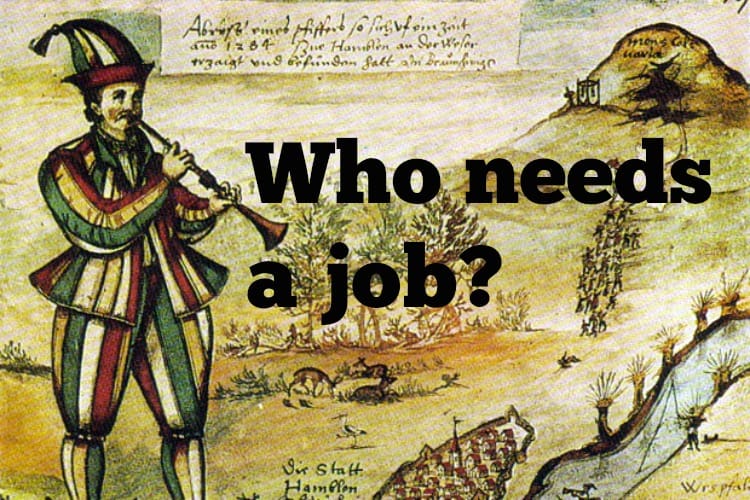The Pied Piper: What an 800-Year-Old Myth Can Teach About Business Leadership
September 15, 2017 by Josh Hrala
The Pied Piper is one of those stories that you read as a child that seems to pop up in everyday conversations far more often than you probably thought it would all those years ago.
Kate Greenaway/WikiMedia Commons
This is largely because the simple story serves as a pretty good reminder that you should pay your debts, keep your promises, and stop messing around with magic pipe-wielding people that show up in your town no matter what they claim they can do about your current rat problem.
And, while all three of those things are true – especially the last one – the Pied Piper tale also serves as a warning for business leaders, too. Or does it?
Before we get into it, though, we need a quick refresher on the legend. So buckle up, here comes a brief history lesson:
The Pied Piper: A Quick Recap
While many experts are still unsure when the story originated, evidence – in the form of a stained glass window – suggests that it came about sometime before the 1300s in Hamelin, Germany, the same town where the story is set.
In the original tale, the town of Hamelin has a rat problem, which prompts the mayor to hire a rat-catcher who claims he can lure the rats out of the town and into the river with his trusty magical flute.
loki11/WikiMedia Commons
To get a sense of the man himself, here’s how Robert Browning, in his poem The Pied Piper of Hamelin, describes him:
“Please your honors,” said he, “I’m able, / By means of a secret charm, to draw / All creatures living beneath the sun, / That creep or swim or fly or run, / After me so as you never saw! / And I chiefly use my charm / On creatures that do people harm, / The mole and toad and newt and viper; / And people call me the Pied Piper.”
(Fun fact: ‘pied’ means wearing more than one color at a given time. For some reason, we barely use that term anymore.)
To everyone’s surprise, the Piper is successful, drawing out all of the rats and having them drowned in a river nearby. Then, for some weird reason, the mayor decides that he doesn’t like the original deal and tries to pay the Piper less than they agreed upon (in some versions he doesn’t pay him at all).
This upsets the Piper who then – like a maniac – uses his magical flute to lure all of the town’s children into a forest (or a cave or a mountain or Transylvania, depending on what story you’re reading).
In total, many of the stories say that the Piper led 130 children from the town while the adults were busy in church. Only three of the town’s children did not come because one was deaf and unable to hear the flute, one was hurt and couldn’t keep up, and the last was blind and couldn’t find the way. When the adults came out of church, these three children broke the news to them.
There are typically three endings to the story, too. One is that the children were led to their deaths like the rats were, one is that they were returned after payment was made, and the other is that they were returned after the villagers paid way more than the agreed upon price.
Given the story’s long history, it’s changed quite a bit. In fact, no one really knows why it came about. We do know – based on written records – that the church of Hamelin had a depiction of the Piper on one of its stained glass windows that dates back to the 1300s.
Also, the town of Hamelin started to record history after whatever event took place with the Piper. In 1384, an ominous note was left in the town’s chronicle that read: “It is 100 years since our children left.”
Okay, that’s super spooky. So, what does this have to do with business? Good question, let’s root this thing in some facts.
The Pied Piper Might Have Been a Talent Scout or Head Hunter
You read that right. According to new evidence proposed by linguistics professor Jurgen Udolph, from the University of Gottingen, the Pied Piper might have actually been a “locator,” which would have been the name given to a person who went around looking for young adults to come work in other towns.
In other words, the Pied Piper was likely a talent scout.
Augustin von Moersperg/WikiMedia Commons/Careerminds
“They were recruited in their home towns and villages by “locators” – the medieval equivalent of head-hunters,” reports Imre Karacs for The Independent.
“‘Go east, young man,’ they preached on village squares, promising rich rewards for colonists. Documents going back five centuries show that on 26 June 1284, Hameln lost 130 young souls.”
While this firmly roots the story of the Pied Piper in the business world. A talent scout is never what’s on someone’s mind when they attribute someone a “Pied Piper-like magic”. When we call leaders Pied Pipers, it’s usually because they wield an impressive amount of influence over their staff.
And this is where the true problem comes in.
The Pied Piper Effect
In business, strong leaders are invaluable. In fact, some of them seem to have a Pied Piper-like magic to them where their team will follow them so loyally it seems unreal.
If you have Pied Piper-like leaders in your company, it stands to reason that your company will flourish under their guidance, right? Well, the 6 Sigma organization seems to think so.
“So, too, effective leaders must possess, a Pied Piper-like ”magic”, that enables them to call the tune heralding strategy change, confident in the knowledge that the vast majority will follow their lead,” the organization states.
“This, ‘Pied Piper’ ability to influence others is perhaps the most essential skill a leader can have. Even in normal circumstances, when major change is not an issue, a leader without followers is a contradiction in terms, so all leaders, to some extent, must be Pied Pipers.”
According to them, Pied Piper leaders must possess these characteristics:
- Charisma
- Believability
- The ability to inspire loyalty
- The ability to positively make use of channels of influence within the organization
- Top communication skills and
- Skills in turning around dissenters and enlisting pioneers
Thomas van Apshoven/WikiMedia Commons/Careerminds
While it’s easy to see how having those qualities can make a leader have power, it also sounds a bit militaristic doesn’t it? “Dissenters.” That’s a pretty weird word to be throwing around a boardroom.
This is because Pied Piper leaders are not merely looked up to by their peers, they can directly influence them. So, in a way, yes, Pied Piper leadership does make a good military commander or head of state. In fact, there have been articles written about how the Pied Piper effect works within terror organizations.
To boil this all down, Pied Piper leadership is all about having an immense influence on people. So much so, that it’s like you have a magical control over them.
This begs the question: is a Pied Piper a good thing to have in your company?
When Pied Piper-ing Goes Awry
Now, if you’re the boss of one of these Pied Pipers and they have a team behind them that works hard, gets jobs done, and generally don’t cause a fuss, you probably see nothing but positives when it comes to this type of leadership.
And, you’d be generally right. If things go well, your Pied Piper might keep chugging along, making sweet, sweet profits.
But that’s ignoring the other half of the story.
We seem to only look at the one side of the myth, applauding the Piper’s magical leadership talents while forgetting that he then, you know, kidnapped a bunch of children using the same flute he used to save the city from rats.
So, if we view the Piper’s flute as his leadership skills, it stands to reason that we like the Piper when he is using the flute to make us money, bring teams together, and save our towns from rats, but if we wrong the Piper, he turns around and uses that same flute to destroy our businesses and – in the story – our lives.
How can this play out in the business world?
Okay, let’s separate the myth from reality here. You have a strong leader who knows they are strong. They are self-aware enough to realize that they are in a position of authority and power over their given team.
Now, say that leader wants a raise or has some other request that you can’t fulfill. What do you do? In other words, can you pay the Piper?
Oskar Herrfurth/WikiMedia Commons/Careerminds
If you can’t, you might have a problem on your hands because the Piper in this scenario wields a massive influence over their staff, possibly turning them against you.
If the Piper leaves your company to work for a competitor, for example, do his ex-staffer look to you to fill the role or will he – like in the story – march them out of the company behind him?
This example can play out many ways. Say the Piper gets laid off because his position was redundant. Will his staff stay or will they go, too? Will they start to “dissent”?
Obviously, the solution here is to be a Piper yourself, which is why the 6 Sigma folks have an article about it. And, while that is logical advice, you should attempt to run an organization that isn’t so polarizing in the first place.
The employees of your company shouldn’t rally behind one single individual. They should rally around your company as a whole. After all, a company is just one, really large team. If they are not onboard with that idea and are instead following a single person, you have some organizational workforce issues happening internally that need addressed.
Pied Piper: Good or Bad?
The takeaway here is that Pied Piper leadership – while it seems amazing on the surface because, well, it is, can also be a double edged sword.
If you foster strong leaders, it’s important that you also foster company loyalty, too. Make everyone a part of the same team.
Pied Pipers, in other words, are powerful things, and we shouldn’t forget the latter half of the myth if we are telling ourselves that leaders should try to evoke that level of influence, which seems to be a common piece of advice given how many articles there are about ‘Pied Piper Leaders’.
Just remember: at the end of the day, someone has to pay the Piper, and if your organization is not up to the task (or simply falters enough to trigger the Piper to action) you can find yourself in a weird spot.
More from Careerminds
In need of outplacement assistance?
At Careerminds, we care about people first. That’s why we offer personalized talent management solutions for every level at lower costs, globally.








